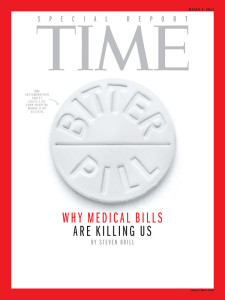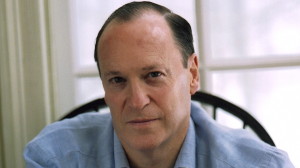Public scrutiny of exorbitant hospital ‘chargemaster’ prices for health services and medical laboratory tests is growing
Publication by Time Magazine of an in-depth investigation of the exorbitant prices charged to patients by many hospitals continues to cause a stir among both healthcare policymakers and patient advocates. Clinical laboratory executives and pathologists should take note of this public debate.
The exposé was published by Time on March 4 under the title “Bitter Pill: Why Medical Bills Are Killing Us”. It was authored by prominent journalist and entrepreneur Steven Brill, the founder of Court TV. Dark Daily suggests that this is useful reading for pathologists and clinical laboratory managers who want to stay abreast of the trend to provide patients with greater transparency in hospital prices and outcomes.
Do Provider Prices Contribute to the High Cost of U.S. Healthcare?
Lack of transparency in the origin of healthcare costs and its impact on the nation’s economic health is under increasing scrutiny. Now, in a ‘manifesto’ on healthcare costs, Brill has boosted media attention on how healthcare providers arrive at the charges they bill to patients. Because Brill is a high-profile writer, his decision to take up the topic is significant.
What made this story different, according to Brill, was the fact that he took actual medical bills and dissected them line by line. He spent seven months analyzing hundreds of bills from various healthcare providers. For the first time, Time magazine devoted an entire issue to one writer’s story.
Searching Out the Genesis of ‘Wildly Expensive’ Healthcare
For Brill, the healthcare reform debate prompted a nagging question, according to Brill’s opinion piece published on reuters.com. “Everyone on all sides seemed to accept as a given that healthcare was wildly expensive,” he wrote. “[T]he only debate seemed to be over who should pay for it. I wondered: Well, why is it so expensive in the first place? Who is setting these prices, and who is pocketing the biggest profits?”

Here is the cover of the March 4, 2013, issue of Time Magazine. It contains a detailed investigation of healthcare prices—including hospital chargemaster prices—conducted by journalist Steven Brill. (Image copyright Time Magazine.)
From there, Brill set out to dissect the medical bills of seven patients. He then traced the money back, essentially to determine answers to three questions:
- Who was setting prices?
- Who got paid what?
- Who was making what levels of profit or sustaining what levels of losses?
Review of Patients’ Bills Exposes Price-Gouging by Hospitals
Brill concluded that exorbitant prices and profits are at the core of America’s [healthcare] crisis. Also a lawyer, he pointed to financial reports hospitals are required to file with the government every year, as the best evidence.
“By following the money, I discovered that our healthcare prices are out of whack for a reason that was hiding in plain sight,” stated Brill in the Reuters story. He was referring to the price list used by hospitals known as the “chargemaster.”
“Brill’s reporting on chargemasters explains why healthcare providers charge widely different prices for the same services, even within a single geographic area,” stated the editors of Bloomberg, in an editorial response to Brill’s story.
“Chargemasters contain laughably high prices that hospital administrators don’t even try to justify.”
They observed that hospital executives argue these lists are misleading because payers always negotiate lower rates. “Yet people without insurance, or with too little insurance, often end up paying chargemaster prices,” the Bloomberg team wrote. “[I]t comes as a shock to learn how many [hospitals] are engaging in…price gouging,”
Everyone along the Supply Chain is Reaping a Bonanza
Overcharging went beyond just hospitals, according to Brill.
“When I followed the money trail behind the drugs, medical devices, or CT scan equipment that the patients or their insurance companies were billed for, the profit margins for the hospitals that supplied them, as high as they were, were eclipsed by the margins of the manufacturers that sold them to the hospitals,” he wrote in the Time story. “In the case of the drug companies, their research and development costs…were not nearly high enough to justify prices.” Brill based his claim on his review of securities filings, according to the Reuters story.
Journalist, entrepreneur, and lawyer, Steven Brill, has stirred up renewed attention on the lack of transparency in how hospitals set prices for healthcare services. Brill wrote the story after pondering, not who should pay for the high costs of healthcare services, but why the costs are so high in the first place. After a seven-month investigation into actual patients’ bills, Brill wrote a 36-page story, which was published by Time magazine.

According to Brill, the real issue isn’t whether we have a single payer or multiple payers, but whether whoever pays has a “fair chance in a fair market.” The message for pathologists and clinical laboratory managers is that transparency in pricing and healthcare service delivery is a trend that is here to stay. (photo by Lewis James and copyright ednewscolorado.org.)
The only exceptions, Brill further observed in the Reuters story, were doctors and nurses actually treating the patients. However, even some doctors were gaming the system by reaping consulting fees from drug or device makers. “Others were setting up diagnostic clinics in order to steer patients there for expensive tests,” Brill stated.
The movement toward transparency in healthcare, including how prices are determined, is a separate trend in the reform of healthcare in the United States. It is powerful and expected to be transformational in changing how consumers select hosptials, physicians, and other providers. Pathologists and clinical laboratory managers should pay attention to their own price lists and how they provide clear, objective lab test price information to patients and self-pay consumers.
—Pamela Scherer McLeod
Related Information:
Bitter Pill: Why Medical Bills Are Killing Us
Bitter Pill: Inside TIME’s Cover Story on Medical Bills
Coming up with “A Bitter Pill”
Bringing Down Health-Care Costs Isn’t Always Complicated
Hospitals dismiss significance of chargemaster prices
If you go to the hospital, beware of the chargemaster



